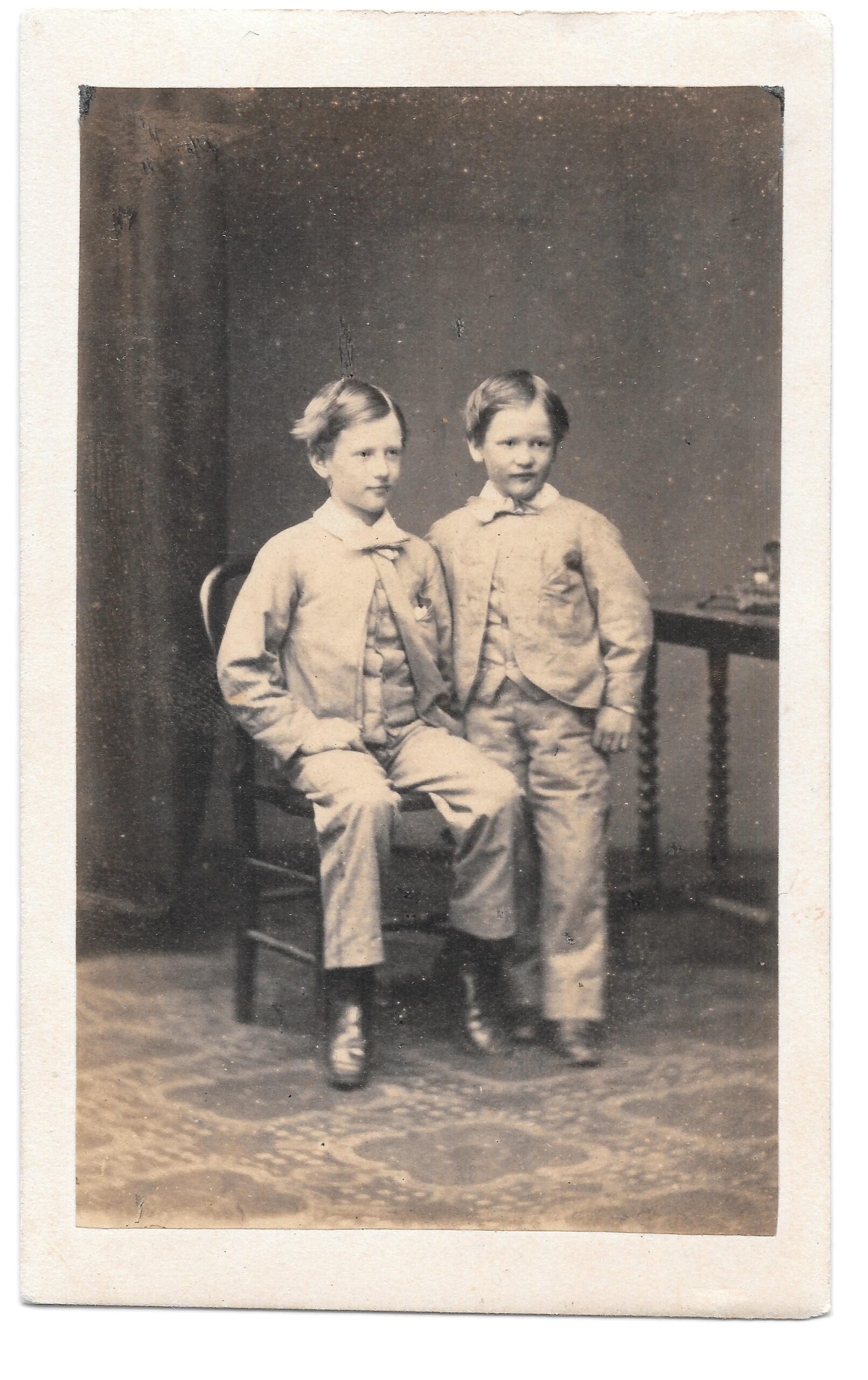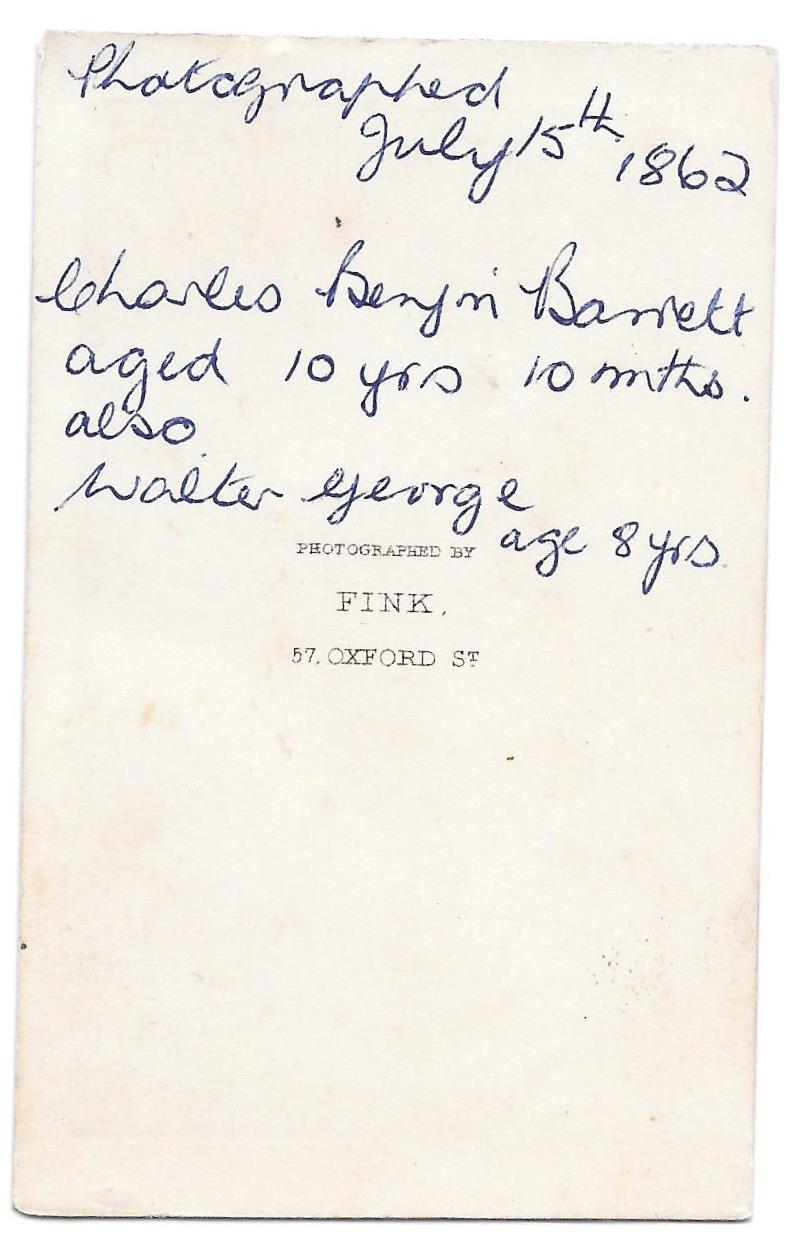Charles Benjamin Barrett and Walter George Barrett
 This Charles Benjamin Barrett and Walter George photograph 1862, taken on 15th July by photographer Fink of 57 Oxford Street, London, depicts Charles Benjamin Barrett, aged 10 years and 10 months, seated, alongside Walter George, aged 8 years, standing.
This Charles Benjamin Barrett and Walter George photograph 1862, taken on 15th July by photographer Fink of 57 Oxford Street, London, depicts Charles Benjamin Barrett, aged 10 years and 10 months, seated, alongside Walter George, aged 8 years, standing.
Both boys are dressed in formal matching suits, complete with neatly tied collars, waistcoats, and polished boots — a clear sign of middle-class respectability in Victorian England, where presentation often reflected a family’s social aspirations. The care taken in their grooming and attire suggests parental involvement and a desire to convey propriety, discipline, and affection. Their composed expressions, combined with the carefully arranged pose, indicate that the photograph was a carefully planned and meaningful occasion. It may have been taken to commemorate a birthday, the start or end of school, or another family milestone — or perhaps simply to preserve a lasting visual record of the children at that moment in time. In an era when photography was still relatively costly and uncommon for working families, such a portrait would have been both a prized possession and a testament to a family’s sense of legacy.
Charles, born around October 1846, would later live in Bush Hill Park, Enfield. His life ended tragically in 1905 following a prolonged period of mental distress, as recorded in a Coroner’s inquest published in the Middlesex Gazette. The younger boy, Walter George, is believed to be his younger brother or close relative, born circa 1854.
 This image offers a rare and touching glimpse into the early lives of two Victorian boys—capturing not just their likenesses, but the values and visual language of their time.
This image offers a rare and touching glimpse into the early lives of two Victorian boys—capturing not just their likenesses, but the values and visual language of their time.
The Middlesex Gazette, Saturday, August 26, 1905
Sad Case of Suicide.
The circumstances surrounding the death of Charles Benjamin Barrett (referred to in our last issue) formed the subject of a Coroner’s Inquest at the George Hotel, Enfield Town, on Friday afternoon last.
Emily May Barrett said the deceased was her husband, and they resided at 10, Charles-street, Bush Hill Park. Deceased was 58 years of age, and a portmanteau maker by trade. He had been strange in manner and absent-minded for some time past, and there was a vacant expression in his eyes. He was also subject to fits of giddiness. On Saturday, the 12th inst., witness accompanied the deceased to Dr. Greenwood’s surgery, and that gentleman prescribed for him.

On the following day (Sunday) he did not rise, and appeared in a depressed condition, and expressed fear that things in the house were going wrong. On Monday he went to Dr. Greenwood again, and on the next day he appeared to be somewhat brighter, as Dr. Greenwood had sent him some medicine. On Wednesday night deceased got out of bed and walked about the room. He was very restless, and said he could not sleep. Witness asked him why he did not try to sleep, and he replied, “You lie down and go to sleep; that is all I want you to do.” Witness said: “Do you know where the matches are?” to which deceased replied petulantly, “No.” Witness next observed him in a bending attitude. He then struck a match and took something from a drawer. Witness then sprang out of bed and took the matches from him. She saw he had a white-handled razor, which she snatched from him. She then called her son, who fetched a neighbour, and also ran to Mrs. Streek, who had come to see her sister.
Mrs. Streek, wife of Frederick Street, of 10, John-street, Bush Hill Park, said at about one o’clock on the morning of Tuesday, 15th inst., she was called to Mrs. Barrett’s assistance. Witness proceeded upstairs and saw the deceased standing by the dressing-table, and over a vessel apparently holding open a wound in his throat. She exclaimed: “Mr. Barrett, for God’s sake don’t do it!” and she then ran to him, but he prevented her. She then rushed out of the room and called out, “Send for the police.” Then her husband, with two policemen, arrived. Witness was present when Dr. Hurst said something to the effect—
At 2.15 on Tuesday morning, he was informed by John Streek, of 10, John-street, and others, that a man had cut his throat, and on going to that address saw deceased in bed. He had a cut across his throat, and the wound was tied up with a bandage. He was then quite conscious. Dr. Greenwood arrived shortly afterwards, and rendered medical assistance. Witness sent for the police ambulance, and conveyed the man to Edmonton Infirmary. He was then quite rational, and said he could not understand what he had been doing. Witness deemed it a very singular thing he should experience fits of giddiness and then commit the terrible act. A short time afterwards deceased became exhausted and placed in the ambulance. Dr. Greenwood, who was in the van, rendered proper attention. The body was removed to the mortuary.
Mrs. Roberts, of 4, East Crescent, Bush Hill Park, deposed that she first saw the deceased about 18 months ago, when he was suffering from depression. He sent him to a London hospital as an out-patient. He next saw him on Saturday, the 12th, when he was in exactly the same condition. He prescribed for him, and decided it was necessary he was watched more by Mrs. Barrett. Witness said he could not say he was mentally affected. He advised Mrs. Barrett to get him into the Infirmary. On Tuesday night the witness was called and found him in acute mania, with a knife under his chin. So violently did he struggle that it was necessary to obtain medical aid. With a view to abating the mania, a bromide draught was administered to him. He, however, took no effect, and witness prescribed another and more powerful draught. He improved for the time being, and said he required no more purpose of being watched for two or three hours, but when he left he feared he would again do something.
Daniel Henry Pewsey, of 40, Fotheringham-road, relieving officer, deposed that deceased’s wife came to him on the 15th inst., and stated to him to the effect that she believed her husband was mentally affected. He visited the house the same afternoon, and saw the deceased seated on the top of the bed. He was then wearing the razor round his throat, and refused to let it go. He said he wanted to die. He foamed at the mouth, was very excited, and his mind wandered. Witness thought he was suffering from acute mania. He had formerly said he had a pain in his head, and there was a lump on the side of the skull. Witness made arrangements with the police, and the deceased was sent to the infirmary.
The Coroner (reviewing the evidence), said there appeared to have been no evidence of suicidal tendency, nor had he previously suffered from mania. He had however, shown considerable tact in dealing with the case. Everything possible appeared to have been done to save the unfortunate man’s life, who died as a consequence of a severe cut he had inflicted with his own hand while suffering from mania.
A verdict of temporary insanity was returned.
About Charles Benjamin Barrett and Walter George – July 15th, 1862
The studio portrait, taken on 15th July 1862 by photographer Fink of 57 Oxford Street, London, depicts Charles Benjamin Barrett, aged 10 years and 10 months, seated, alongside Walter George, aged 8 years, standing.
Both boys are dressed in formal matching suits, complete with neatly tied collars, waistcoats, and polished boots — a clear sign of middle-class respectability in Victorian England, where presentation often reflected a family’s social aspirations. The care taken in their grooming and attire suggests parental involvement and a desire to convey propriety, discipline, and affection. Their composed expressions, combined with the carefully arranged pose, indicate that the photograph was a carefully planned and meaningful occasion. It may have been taken to commemorate a birthday, the start or end of school, or another family milestone — or perhaps simply to preserve a lasting visual record of the children at that moment in time. In an era when photography was still relatively costly and uncommon for working families, such a portrait would have been both a prized possession and a testament to a family’s sense of legacy.
Charles, born around October 1846, would later become a portmanteau maker and reside in Bush Hill Park, Enfield. His life ended tragically in August 1905, following a prolonged period of mental illness and a well-documented coroner’s inquest into his death, as reported in the Middlesex Gazette. His story is a poignant reminder of how mental health was poorly understood and often quietly endured in Edwardian England.
Walter George, the younger of the two, is believed to have been born around 1854, and his life took a quieter course. He outlived his elder brother by over twenty years and died in Ealing in January 1928.
In later life, the brothers followed separate paths, yet their childhood portrait remains a shared legacy. Though their adult lives diverged, this 1862 photograph endures as a rare and intimate reminder of their bond — capturing them side by side in youth, united in family, appearance, and memory.
